When passing through the gate there's a landmark on the right side pillar which reads "The Prince Jayakarta (Achmad Jaketra) Tomb Complex, built 1640 AD in Jatinegara Kaum, Tomb of the fighters who fought the Dutch colonialists." The year of 1640 was the year Prince Jayakarta died. While the landmark on the pillar of the gate on the right reads: "Masjid Jami" Assalafiyah ", built in 1620 AD in Jatinegara Kaum by Pangeran Jayakarta (Achmad Jaketra)".

Kanopi yang merentang dari gerbang sampai ke bangunan utama masjid, meskipun bermanfaat secara fungsional, namun menutupi pandangan ke arah Masjid Assalafiyah dan merusak keindahan arsitektur masjid. Sangat disayangkan. Berita bagusnya, kanopi ini sekarang sudah diganti dengan bangunan baru yang terlihat jauh lebih baik.
The canopy that extended from the gate to the main building of the mosque, although functionally useful, but obscured the view towards the Masjid Assalafiyah and damaged the architectural beauty of the mosque. It's quite unfortunate. The good news is, this canopy had been replaced with a new building which looked much better.
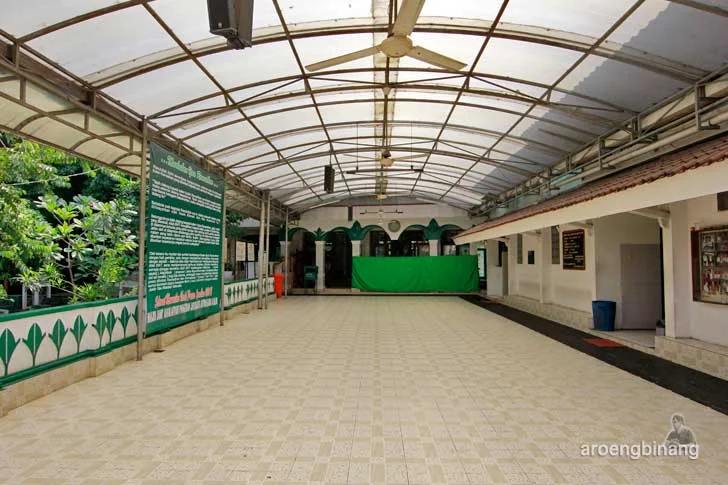
Papan tengara tanah wakaf Masjid Assalafiyah serta status Cagar Budaya yang berada di sisi kiri lorong, menutupi sebagian pandangan ke arah Makam Pangeran Jayakarta
The landmark board for the donated land of the Masjid Assalafiyah and the status of Cultural Heritage located on the left side of the hallway, partially covering the view towards Prince Jayakarta Tomb back there, under a cupola without walls, under a huge banyan tree. Some of the tombs were new ones, unlike the Tomb of Pangeran Sanghyang which were all old tombs.

Pemandangan bagian dalam masjid, arah ke mihrab, membelakangi area yang diperuntukkan bagi wanita. Pintu masuk masjid berada di sebelah kiri.
A view of the mosque's interior, towards the mihrab, behind the area reserved for women. The entrance to the mosque is on the left.
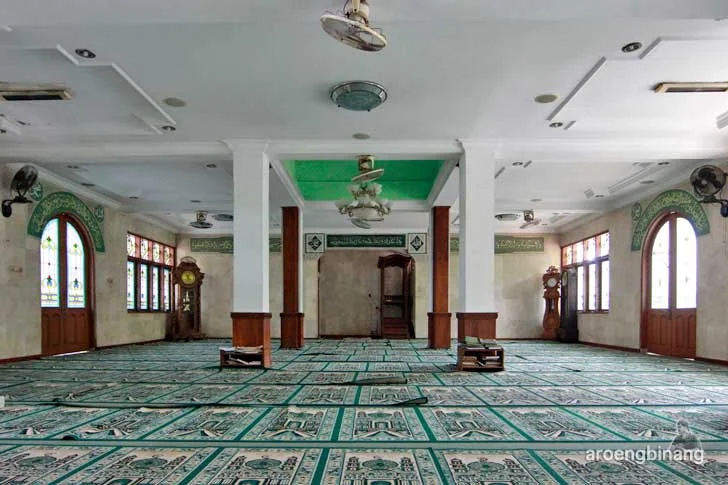
Kaca-kaca patri menghiasi pintu-pintu dan jendela masjid, yang merupakan sumber utama pencahayaan ruangan saat siang, lantaran bagian atas ruangan praktis tertutup beton, menyisakan sedikit lubang segi empat pada bawah cungkup masjid.
Stained glass adorned the doors and windows of the mosque, which was the main source of room lighting during the day, because the upper part of the room was practically covered with concrete, leaving a small rectangular hole under the cupola of the mosque.

Bagian dalam cungkup Masjid Assalafiyah, dengan kaca-kaca patri di keempat sisinya, dan lampu gantung kristal berisi 12 lampu kecil dan sebuah lampu besar di bagian tengah.
The inside of the cupola of the Assalafiyah Mosque, with stained glass on all four sides, and a crystal chandelier containing 12 small lamps and a large lamp in the middle.
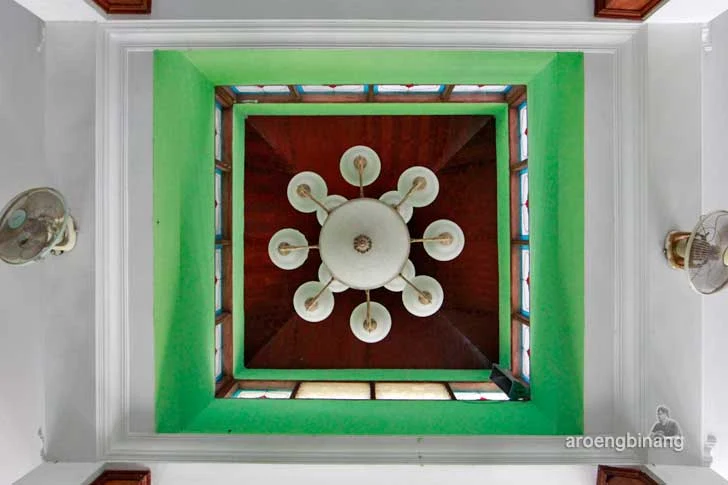
Pilar-pilar Masjid Assalafiyah yang terbuat dari beton dan kayu jati. Bahan dari kayu terlihat lebih klasik dan anggun, namun memang ada umurnya, kecuali jika sudah diolah agar tahan cuaca dan tak digerogoti ngengat dan rayap.
The pillars of the Assalafiyah Mosque were made of concrete and teak wood. The material from wood looked more classic and elegant, but it did have its age, unless it's processed to be weather-resistant and not eaten by moths and termites.
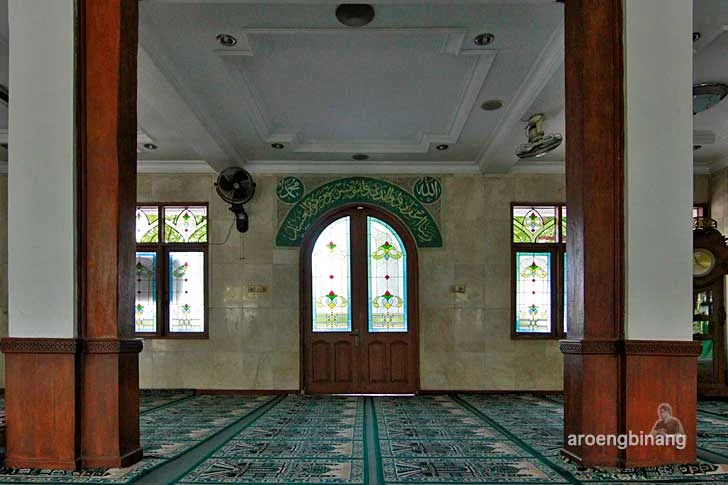
Selain mimbar kayu jati pada mihrab dan tulisan kaligrafi di sepanjang dinding atas, diantaranya huruf kaligrafi Allah dan Muhammad, terdapat tiga buah jam kayu besar berdiri di pojok depan ruangan.
In addition to the teak pulpit at mihrab and calligraphy writing along the upper walls, including the calligraphy letters of Allah and Muhammad, there were three large wooden clocks standing in the front corner of the room.
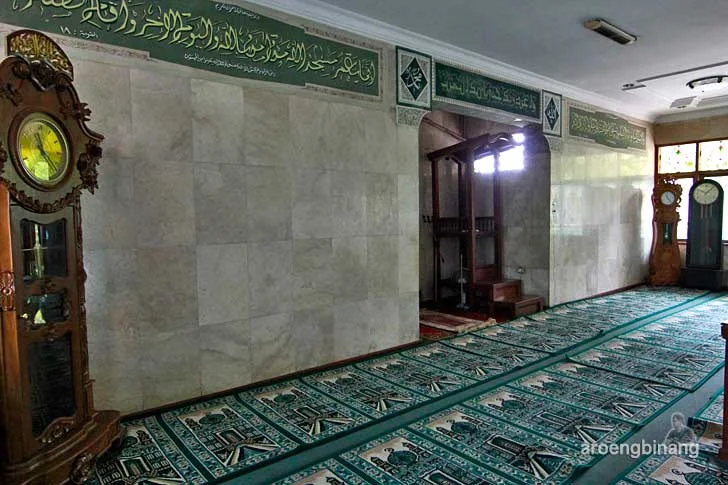
Tepat di samping luar pintu utama Masjid Assalafiyah terdapat sebuah bedug besar, lengkap dengan kentongannya, yang semuanya terbuat dari kayu jati. Yang menarik pada bedug ini adalah paku-paku dan pasak-pasak besar bundar yang melekatkan kulit bedug pada rangkanya, sementara pada kayu jatinya sendiri tidak terlihat ada ornamen ukir yang menonjol.
Right outside the main door of the Assalafiyah Mosque there's a large mosque drum, complete with kentongan, all of which are made of teak wood. What's interesting about this drum or bedug is the nails and large round pegs that attach the drum skin to the frame, while the teak wood itself does not show any prominent carved ornaments.
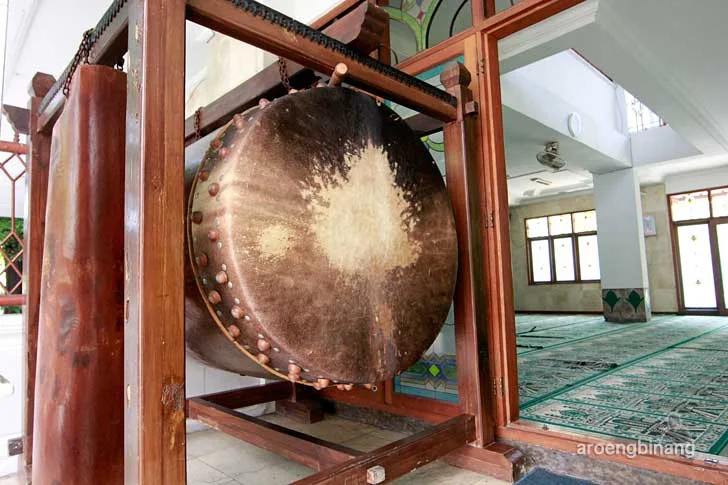
Pintu pagar yang berada tepat di depan pintu masuk ke ruang Masjid Assalafiyah ini menjadi awal lintasan menuju cungkup Makam Pangeran Jayakarta di ujung sana yang berada di bawah sebuah pohon beringin yang sangat besar.
A fence door located right in front of the entrance to the Masjid Assalafiyah room is the starting point of the path to cupola of Prince Jayakarta Tomb at the other end under a huge banyan tree.

Pandangan pada pintu yang berada di seberang pintu masuk utama dengan kaligrafi melengkung di atas pintu. Kaca patri pada daun pintu dan daun-daun jendela terlihat masih cantik.
A view of the door opposite the main entrance with curved calligraphy above the door. The stained glass on the doors and shutters looked still pretty.
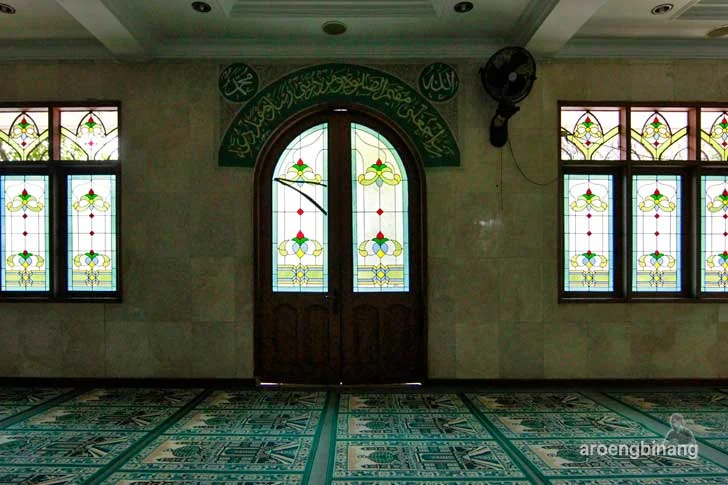
Pandangan ke arah luar dengan memunggungi pintu masuk masjid, dengan kanopi di bagian atas dan kantor sekretariat di sebelah kiri. Terakhir saya lewat seingat saya kanopi ini sudah tidak ada lagi.
A view outward with my back to the entrance of the mosque, with a canopy at the top and the secretariat office on the left. The last time I passed, as I remembered, this canopy was no longer there.

Pandangan ke arah Makam Pangeran Jayakarta yang ditarik lebih ke belakang dari foto lainnya yang mengarah ke lokasi yang sama. Pilar masjid tampak di sebelah kanan, serta ada tanda cagar budaya di sebelah kiri.
Another view towards Prince Jayakarta Tomb. The mosque pillars could be seen on the right, and there's a cultural heritage sign on the left.

Label:
Bagikan ke: WhatsApp, Email. Print!.
